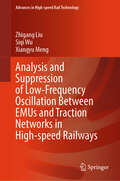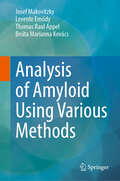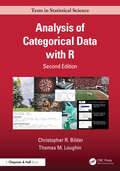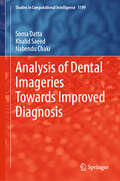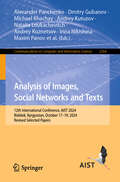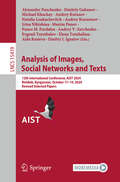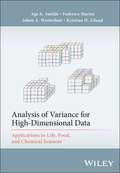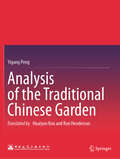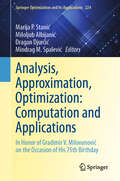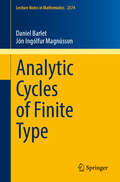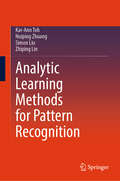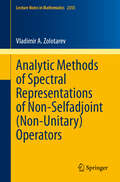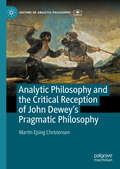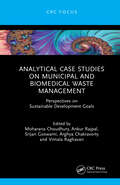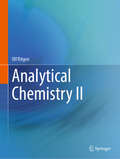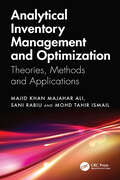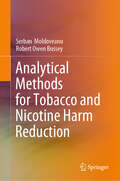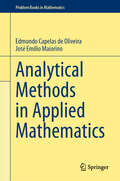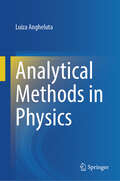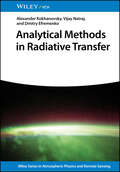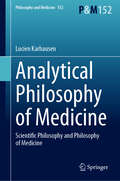- Table View
- List View
Analysis and Suppression of Low-Frequency Oscillation Between EMUs and Traction Networks in High-speed Railways (Advances in High-speed Rail Technology)
by Zhigang Liu Siqi Wu Xiangyu MengThis book focuses on the low-frequency oscillation between EMUs and traction networks in high-speed Railways. As the power source of high-speed trains, the traction network's power performance directly affects the safe and stable operation of the train. However, the low-frequency oscillation between EMUs and traction networks will fluctuate voltage or current, resulting in poor power quality, electrical device failure, and even interruption of traction power. Therefore, it is important to reveal the mechanism of low-frequency oscillation and propose suppression strategies. This book systematically shows the newest research results of analysis and suppression of low-frequency oscillation between EMUs and traction networks in high-speed railways, especially in the modeling methods of vehicle-grid systems and suppression strategies for low-frequency oscillation. These methods or strategies can provide important references and help for researchers, scholars, and engineers on traction power technology in high-speed railways. The main contents include the overview of low-frequency oscillation between EMUs and traction networks, the introduction of main modeling methods for vehicle-grid systems, especially single-phase rectifiers, the line-side converter control algorithms in vehicles for the suppression of low-frequency oscillation, the traction substation power compensation strategies for the suppression of low-frequency oscillation, etc.
Analysis of Amyloid Using Various Methods
by Josef Makovitzky Levente Emődy Thomas Raul Appel Beáta Marianna KovácsThis book explores the world of amyloid, consisting of heterogeneous deposits that have captivated scientists for decades. Amyloid, characterized by its highly organized insoluble protein fibrils exhibiting cross-layered quaternary beta-sheet structures, comprises diverse components such as the P-component, sialic acid, O-acyl sialic acid, and sGAG components. This assembly forms an anisotropic entity that induces birefringence in linearly polarized light, creating a distinctive optical signature. Initially linked to human disease and tissue damage, the predominant idea that amyloid only harms the host has been challenged. Recent pioneering studies have uncovered the existence of functional amyloid fibers in unexpected domains, from bacteria to mammals. Advances during the 1960s and 1970s, along with seminal immunohistochemical investigations, gave impetus to immunobiological analysis of amyloid in the 1980s. Notable work, such as the exploration of amyloid fiber staining techniques and the comprehensive study of histochemical properties, have enriched the understanding of this enigmatic deposit. The book presents a current overview of amyloid research in health and disease, with contributions from the prestigious biennial Amyloid Forum. Written by a distinguished researcher with nearly five decades of experience, the book encompasses five meticulously elaborated chapters. From human and animal deposits to bacterial formations, isolated fibrils, prions, and amyloid-related neurodegenerative disorders, each category of deposit is given a thorough examination. Innovative topo-optical staining techniques - polarization microscopy, fluorescence microscopy and confocal laser scanning fluorescence microscopy - reveal intricate structures in all species. Coherent structural features are authenticated by various staining reactions and different digestions. A key segment dissects animal prion fibers, revealing their intricate architecture by topo-optical reactions and uncovering selective arrangements of components. To complete this, the book confirms the postulated helical structure of the amyloid fiber. This innovative idea is validated by laser scanning confocal fluorescence microscopy, which reveals ordered and helically stacked amyloid protein fibrils in β-sheet conformation. Associations with chondroitin, heparan sulfate, and looser sphingolipid linkages further unravel the structural complexities of amyloid. Also offers an insightful journey into the realm of amyloid, combining historical knowledge with cutting-edge methodologies, redefining the understanding of this intricate phenomenon.
Analysis of Categorical Data with R (Chapman & Hall/CRC Texts in Statistical Science)
by Christopher R. Bilder Thomas M. LoughinAnalysis of Categorical Data with R, Second Edition presents a modern account of categorical data analysis using the R software environment. It covers recent techniques of model building and assessment for binary, multicategory, and count response variables and discusses fundamentals, such as odds ratio and probability estimation. The authors give detailed advice and guidelines on which procedures to use and why to use them.The second edition is a substantial update of the first based on the authors’ experiences of teaching from the book for nearly a decade. The book is organized as before, but with new content throughout, and there are two new substantive topics in the advanced topics chapter—group testing and splines. The computing has been completely updated, with the "emmeans" package now integrated into the book. The examples have also been updated, notably to include new examples based on COVID-19, and there are more than 90 new exercises in the book. The solutions manual and teaching videos have also been updated.Features: Requires no prior experience with R, and offers an introduction to the essential features and functions of R Includes numerous examples from medicine, psychology, sports, ecology, and many other areas Integrates extensive R code and output Graphically demonstrates many of the features and properties of various analysis methods Offers a substantial number of exercises in all chapters, enabling use as a course text or for self-study Supplemented by a website with data sets, code, and teaching videos Analysis of Categorical Data with R, Second Edition is primarily designed for a course on categorical data analysis taught at the advanced undergraduate or graduate level. Such a course could be taught in a statistics or biostatistics department, or within mathematics, psychology, social science, ecology, or another quantitative discipline. It could also be used by a self-learner and would make an ideal reference for a researcher from any discipline where categorical data arise.
Analysis of Dental Imageries Towards Improved Diagnosis (Studies in Computational Intelligence #1199)
by Khalid Saeed Nabendu Chaki Soma DattaThis book provides an insight on different types of hardware and software-based caries detection methods and their limitations from treatment perspective. The different chapters are motivated to address some of the important gaps in the prevailing approaches and suggest suitable solution to them. Overall, it helps the reader to understand the caries detection methods to identify interproximal and occlusal caries. This also assists the practitioners. The book identifies multiple research issues on dental caries detection that open the practitioners’ horizons to an array of domains from which they can conclude practical insights about their area of interest.
Analysis of Electric Machinery and Drive Systems (IEEE Press Series on Power and Energy Systems)
by Scott D. Sudhoff Oleg Wasynczuk Paul C. Krause Steven D. PekarekNew edition of the popular reference on machine analysis, focusing on reference frame theory with techniques for derivation of equations Analysis of Electric Machinery and Drive Systems covers the concepts needed to understand the evolution of electrical and magnetic variables for designing the power-electronic circuits that supply or extract electrical energy from a variety of machines, comprehensively addressing the varied needs of readers in the electric machinery, electric drives, and electric power industries. This fourth edition has been extensively revised and updated to include nine new or updated chapters on symmetrical three-phase stators, symmetrical induction machines, brushless DC machines, synchronous machines, neglecting electric transients, eigenvalues and voltage-behind-reactive machine equations, direct current machine and drive, and torque control of permanent-magnet and synchronous reluctance machines. Introductory concepts related to the subject have also been expanded upon, detailing stationary magnetically coupled circuits, energy balance relationships, energy in coupling field, and steady-state and dynamic performance of electromechanical systems. The fourth edition also includes illustrations of the free-acceleration characteristics of induction and brushless dc machines viewed from various reference frames and many other topics. With problems at the end of each chapter to reinforce learning, the book explores additional topics including: Operational impedances and time constraints of synchronous machines, covering Park’s equations in operational form and parameters from short-circuit and frequency-response characteristicsFully controlled three-phase bridge converters, covering six-step, sine-triangle, space-vector, hysteresis, and delta modulations, along with open- and closed-loop voltage and current regulationsMotor drives, covering volts-per-hertz, constant slip current, field-oriented, and direct torque control as well as slip energy recovery drives Brushless DC motor drives, covering average-value analysis, steady-state performance, and transient and dynamic performance of voltage-source inverter drives Analysis of Electric Machinery and Drive Systems, Fourth Edition, is a perfect resource for electrical engineering students and an essential, up-to-date reference for electrical and mechanical engineers working with drives.
Analysis of Images, Social Networks and Texts: 12th International Conference, AIST 2024, Bishkek, Kyrgyzstan, October 17–19, 2024, Revised Selected Papers (Communications in Computer and Information Science #2364)
by Panos M. Pardalos Dmitry Gubanov Andrey V. Savchenko Dmitry I. Ignatov Alexander Panchenko Michael Khachay Natalia Loukachevitch Andrey Kutuzov Elena Tutubalina Andrey Kuznetsov Evgenii Tsymbalov Irina Nikishina Maxim Panov Aida KasievaThis book constitutes the refereed proceedings of the 12th International Conference on Analysis of Images, Social Networks and Texts, AIST 2024, held in Bishkek, Kyrgyzstan, during October 17–19, 2024. The 12 papers included in this book were carefully reviewed and selected from 54 submissions. They were organized in topical sections as follows: natural language processing; computer vision; and data analysis and machine learning.
Analysis of Images, Social Networks and Texts: 12th International Conference, AIST 2024, Bishkek, Kyrgyzstan, October 17–19, 2024, Revised Selected Papers (Lecture Notes in Computer Science #15419)
by Panos M. Pardalos Andrey V. Savchenko Dmitry I. Ignatov Alexander Panchenko Michael Khachay Natalia Loukachevitch Andrey Kutuzov Elena Tutubalina Andrey Kuznetsov Evgenii Tsymbalov Irina Nikishina Maxim Panov Dmitriy Gubanov Aida KasievaThis book constitutes the refereed proceedings of the 12th International Conference on Analysis of Images, Social Networks and Texts, AIST 2024, held in Bishkek, Kyrgyzstan, during October 17–19, 2024. The 16 full papers included in this book were carefully reviewed and selected from 70 submissions. They were organized in topical sections as follows: Natural Language Processing; Computer Vision; Data Analysis and Machine Learning; and Theoretical Machine Learning and Optimization.
Analysis of Variance for High-Dimensional Data: Applications in Life, Food, and Chemical Sciences
by Age K. Smilde Kristian Hovde Liland Federico Marini Johan A. WesterhuisOverview of methods for analyzing high-dimensional experimental data, including theory, methodologies, and applications Analysis of Variance for High-Dimensional Data summarizes all the methods to analyze high-dimensional data that are obtained through applying an experimental design in the life, food, and chemical sciences, especially those developed in recent years. Written by international experts who lead development in the field, Analysis of Variance for High-Dimensional Data includes information on: Basic and established theories on linear models from a mathematical and statistical perspectiveAvailable methods and their mutual relationships, including coverage of ASCA, APCA, PC-ANOVA, ASCA+, LiMM-PCA and RM-ASCA+, and PERMANOVA, as well as various alternative methods and extensionsApplications in metabolomics, microbiome, gene expression, proteomics, food science, sensory science, and chemistryCommercially available and open-source software for application of these methods Analysis of Variance for High-Dimensional Data is an essential reference for practitioners involved in data analysis in the natural sciences, including professionals working in chemometrics, bioinformatics, data science, statistics, and machine learning. The book is valuable for developers of new methods in high dimensional data analysis.
Analysis of the Traditional Chinese Garden
by Yigang PengAnalysis of the Traditional Chinese Garden is a seminal resource for the spatial principles and techniques that shape traditional Chinese gardens. It is a richly illustrated resource for historians, theorists, garden designers, landscape architects, architects and anyone interested in the design of these world renowned gardens with 106 pages of hand-drawn sketches by the author that vividly portray the intricacies and subtleties of traditional Chinese gardens. The book is widely known in China as a primary text for analysis of the gardens and was recognized with the inaugural National Excellent Architectural Book Award in 1990 and, since its debut in China in 1986, has garnered immense popularity and acclaim with 50 reprints and a total print run of 150,000 copies.
Analysis, Approximation, Optimization: In Honor of Gradimir V. Milovanović on the Occasion of His 75th Birthday (Springer Optimization and Its Applications #224)
by Marija P. Stanić Miloljub Albijanić Dragan Djurčić Miodrag M. SpalevićThis contributed volume is dedicated to Academician Gradimir V. Milovanović on his 75th birthday and contains recent results in the fields of approximation theory, numerical analysis, mathematical analysis, optimization theory, and various applications of an interdisciplinary character. Most of these results were presented in person during an International Conference &“Analysis, Approximations and Applications" (AAA2023), organized by the Faculty of Science, University of Kragujevac in Vrnjačka Banja, Serbia (June 21-24, 2023). This book is intended for researchers and students of mathematics and other computational and applied sciences. This book provides surveys of state of the art results in the fields of Extremal Problems, Optimization and Calculus of Variations; Orthogonal Systems and Quadrature Formulas; Differential and Integral Equations, Integral Transforms and Operation Calculus; Analytic Number Theory and Special Functions; Real and Complex Functions, Sequences, Series, Approximations and Expansions; Functional Analysis, Operator Theory, Fixed Point Theory and Iterative Processes, as well as in Miscellaneous Applications.
Analysis, Design, and Construction Aspects of Geotechnical Structures: Select Proceedings of 8IYGEC 2021 (Lecture Notes in Civil Engineering #421)
by V. B. Maji M. Muttharam T. Thyagaraj P. T. Ravichandran G. Janardhanan S. BhuvaneshwariThis book presents the select proceedings of the 8th Indian Young Geotechnical Engineers Conference (8IYGEC 2021) on the following conference themes: Foundation Engineering, Rock Engineering, Slope Stability and Landslides and Deep Excavation and Underground Structures. The book covers a wide range of topics on foundation engineering that include analysis and performance of piled raft foundations, uplift capacity of helical and micro piles, and behaviour of anchor plates. The topics on slope stability and landslides include early warning system for landslides, landslide mitigation and simulation, rainfall induced landslide analysis and slope stability assessment of highway embankments, backfills, concave slopes, coal mine overburden dump and shallow footing on slope. Further, the various aspects of deep excavation and underground structures including the performance predictive models and ground response due to excavations, buried drainage pipe leakage, and urban metro tunnel construction are covered in this book. This book can be a valuable reference for academicians and practicing engineers.
Analytic Cycles of Finite Type (Lecture Notes in Mathematics #2374)
by Daniel Barlet Jón Ingólfur MagnússonThis book highlights the use of non-compact analytic cycles in complex geometry. The main focus is on analytic families of cycles of finite type, in other words, cycles which have only finitely many irreducible components. It is shown how the space of all cycles of finite type in a given complex space, endowed with a weak analytic structure, can be used in many ways as the reduced complex space of all compact cycles in the given space. Several illustrative and enlightening examples are provided, as well as applications, giving life to the theory. The exposition includes a characterization of quasi-proper holomorphic maps which admit a geometric flattening, a proof of an existence theorem for meromorphic quotients with respect to a large class of analytic equivalence relations, and a generalization of the Stein factorization to a variety of holomorphic maps. In addition, a study is made of the behavior of analytic families of finite type cycles when they are restricted to Zariski open subsets and extended across analytic subsets. Aimed at researchers and graduate students with an interest in complex or algebraic geometry, the book is adequately self-contained, the basic notions are explained and suitable references are given for auxiliary results that are used in the text.
Analytic Learning Methods for Pattern Recognition
by Kar-Ann Toh Huiping Zhuang Simon Liu Zhiping LinThis textbook is a consolidation of learning methods which comes in an analytic form. The covered learning methods include classical and advanced solutions to problems of regression, minimum classification error, maximum receiver operating characteristics, bridge regression, ensemble learning and network learning. Both the primal and dual solution forms are discussed for over-and under-determined systems. Such coverage provides an important perspective for handling systems with overwhelming samples or systems with overwhelming parameters. For goal driven classification, the solutions to minimum classification-error, maximum receiver operating characteristics, bridge regression, and ensemble learning represent recent advancements in the literature. In this book, the exercises offer instructors and students practical experience with real-world applications.
Analytic Methods of Spectral Representations of Non-Selfadjoint (Lecture Notes in Mathematics #2355)
by Vladimir A. ZolotarevThis book is concerned with the theory of model representations of linear non-selfadjoint and non-unitary operators. This booming area of functional analysis owes its origins to the fundamental works of M. S. Livšic on the theory of characteristic functions, the deep studies of B. S.-Nagy and C. Foias on dilation theory, and also to the Lax–Phillips scattering theory. Here, a uniform conceptual approach is developed which organically unites all these theories. New analytic methods are introduced which make it possible to solve some important problems from the theory of spectral representations. Aimed at specialists in functional analysis, the book will also be accessible to senior mathematics students.
Analytic Philosophy and the Critical Reception of John Dewey’s Pragmatic Philosophy (History of Analytic Philosophy)
by Martin Ejsing ChristensenThis book examines the critical reception of Dewey&’s pragmatic philosophy by six prominent analytic philosophers and relates it to the contested history of analytic philosophy and Deweyan pragmatism. It argues that analytic philosophers&’ critical reception of Dewey&’s pragmatist philosophy has, from the very beginning, been marred by externalist readings that do not engage with Dewey&’s thinking from the inside, and suggests that this throws doubt upon the new revisionary histories of analytic philosophy and Deweyan pragmatism according to which the marginalization of Dewey&’s pragmatism represents the sensible result of critical processes of reasoning. At the same time, however, the book also points out that Dewey and his analytic critics in fact share several worries and suggests that these common concerns might serve as points of reference for more fruitful dialogues across the traditions of analytic philosophy and Deweyan pragmatism in the future.
Analytical Case Studies on Municipal and Biomedical Waste Management: Perspectives on Sustainable Development Goals
by Srijan Goswami Moharana Choudhury Arghya Chakravorty Ankur Rajpal Vimala RaghavanEffective waste management practices are essential to mitigate unfavourable impacts and achieve the Sustainable Development Goals. This book covers perspectives addressing the Sustainable Development Goals through analytical and case studies on municipal and biomedical waste management. It consists of ten selectively curated highly technical chapters covering various aspects of achieving the Sustainable Development Goals through applying effective waste management strategies and practices through practical case studies and examples.Features: Analysis of over 30 real-life case studies reviewed from local as well as global perspectives Discusses application of technologies in real time Addresses the 17 Sustainable Development Goals at ground level Covers a broad range of case studies on municipal solid waste and biomedical waste treatment and management Reviews the latest evidence-based approach in diagnosis and management This book is aimed at researchers and graduate students in environmental engineering and management.
Analytical Chemistry II
by Ulf RitgenThis workbook takes you through the successful textbook Skoog/Holler/Crouch, Instrumentelle Analytik and is designed primarily for self-study.In five parts, the lecture content of more advanced analytical chemistry is summarized and explained using selected examples: mass spectrometry and nuclear magnetic resonance spectroscopy deal with the investigation of molecules, and numerous electroanalytical methods such as potentiometry, coulometry, amperometry and voltammetry are also covered. An overview of more specialized analytical methods includes the use of radioactive substances and various fluorescence methods, as well as methods of information acquisition in the increasingly important electrochemical and optical sensor technology and their automation. The course concludes with a summary of various principles and application methods of statistics, which are simply indispensable in the context of analytics. In order to facilitate independent learning, references to essential sections and illustrations of the textbook are made throughout the book.Not least because of the numerous examples, the book, which is aimed at students of chemistry or related scientific subjects, provides an easy-to-understand introduction to more complex aspects of analytical chemistry. In direct continuation of the workbook Analytical Chemistry I, references are made again and again to already known basics from other courses, which facilitate the linking of the familiar and the new. Learning with this workbook has been tested in a distance learning chemistry course and facilitates preparation for module examinations in more advanced analytical chemistry.This book is a translation of the original German 1st edition Analytische Chemie II by Ulf Ritgen, published by Springer-Verlag GmbH Germany, part of Springer Nature in 2020. The translation was done with the help of artificial intelligence (machine translation by the service DeepL.com). A subsequent human revision was done primarily in terms of content, so that the book will read stylistically differently from a conventional translation. Springer Nature works continuously to further the development of tools for the production of books and on the related technologies to support the authors.
Analytical Dynamics of Nonlinear Rotors (Nonlinear Physical Science)
by Albert C. Luo Yeyin Xu Jianzhe HuangThis book is a monograph about the analytical dynamics of nonlinear rotor systems. The analytical solutions of periodic motions in nonlinear rotor systems are presented in this book. To help one understand the analytical solutions, the generalized harmonic balance method for periodic motions in polynomial nonlinear systems is briefly reviewed first, and then the semi-analytical method for periodic motions in any nonlinear systems is presented briefly too, which is also called the implicit mapping method. Such two analytical methods are employed to determine the solutions of periodic motions in nonlinear rotor systems. The analytical expressions of periodic motions to chaos for nonlinear rotor systems are presented, and the frequency-amplitude characteristics of nonlinear rotor systems are discussed. In addition, the accurate modeling of nonlinear rotors with oil films is presented, and the periodic motions of such fully nonlinear oil-film rotor systems are developed through the semi-analytical method. This book provides a better understanding of frequency-amplitude characteristics in nonlinear rotor systems. The methodology presented in this book can help one study complicated nonlinear rotor systems.
Analytical Inventory Management and Optimization: Theories, Methods and Applications
by Majid Khan Majahar Ali Sani Rabiu Mohd Tahir IsmailIn this vital resource with discussion of and applicability to various industries, Ali, Rabiu, and Ismail guide readers through the challenging environment of inventory management and enable them to successfully balance the demand and supply of items in stock, a critical task in any field.The book covers a wide range of topics related to inventory management and optimization. After introducing the key concepts and principles of inventory management, such as inventory analytics, optimization, and models, the authors provide a comprehensive and in-depth understanding of various inventory control techniques that are essential for effective inventory management, such as ABC analysis, EOQ model, safety stock, and reorder point. They then introduce various mathematical models and optimization techniques such as system-level and item-level inventory analysis and show how to perform sensitivity analyses to test the robustness of these models. They then look at the role of inventory management in various industries such as supply chain management and logistics, manufacturing, and more; and address the effects and integration of cutting-edge technologies like artificial intelligence, machine learning, and robotics to conventional inventory management practices. Additional topics include inventory forecasting, inventory management systems, inventory auditing and control, risk management. In combining mathematical underpinnings in the area with practical case studies throughout, readers will gain a solid understanding of the real-world applications of these different techniques so that they can apply inventory management and optimization best practices in their workplace.The comprehensive coverage makes the book a valuable reference for practitioners and students, particularly postgraduate and MBA students, who require such insights to improve business functions and make informed decisions. Because it provides the foundational mathematical knowledge required to comprehend any chapter, it is also accessible for readers without a strong background in mathematics.
Analytical Isotope Geochemistry: Techniques and Data Interpretation (Advances in Isotope Geochemistry)
by Gyana Ranjan TripathyIsotopes of radiogenic and non-traditional stable elements have been extensively used for quantitative understanding of earth, planetary, ocean, and climatic processes. More recently, these applications have also been extended to medical, petroleum, forensic, and archaeological sciences. The proposed book aims at providing thorough analytical details for precise (ppm-level) isotopic measurements using state-of-the-art mass spectrometers (e.g., IRMS, TIMS, MC-ICPMS). All essential details on sample handling, chromatographic/solvent-extraction purification, isobaric interferences, spike-sample equilibration, data corrections, and measurement statistics for different isotopes have been reviewed here. It will also provide (i) information on recent technical analytical developments and (ii) &“do's-and-don'ts&” for analyzing isotopic ratios precisely. This book serves as an excellent handbook to set up these systematics with proper scientific rigor in academic and industrial laboratories.
Analytical Methods for Tobacco and Nicotine Harm Reduction
by Serban Moldoveanu Robert Owen BusseyThis book presents a critical review of the analytical methods used for the measurement of harmful and potentially harmful compounds (HPHC) in tobacco and nicotine-related products. In the first chapter of the book, a presentation of the main types of tobacco products is introduced, including cigarettes, cigars, cigarillos, little filter cigars, dissolvable tobacco products, hookah (shisha or waterpipe), nicotine gels, pipe tobacco products, roll your own, smokeless tobacco products, such as dip, snuff, snus, and chewing tobacco and E-Cigarettes, vapes, and other electronic nicotine delivery systems (ENDS). In the second and main part of the book, the analytical methods for the compounds in the established list from the U.S. Food and Drug Administration (FDA) of HPHC are discussed. For example, in cigarette smoke, specific discussions related to the analytical methods for nicotine, acetaldehyde, acrolein, acrylonitrile, aromatic amines, ammonia, benzene, benzo[a]pyrene, 1,3-butadiene, carbon monoxide, crotonaldehyde, formaldehyde, isoprene, TSNA&’s, and toluene are presented. Specific analytical methods for the analysis of HPHC in ENDS are also included. Various other analytical methods used for all the 93 HPHC in the established list by FDA for tobacco products and tobacco smoke are presented. The book will be useful to scientists working in the industry as well as students and researchers interested in the area.
Analytical Methods in Applied Mathematics (Problem Books in Mathematics)
by Edmundo Capelas de Oliveira José Emílio MaiorinoThis book compiles an extensive list of solved and proposed problems in mathematical topics in analysis, aimed at students of mathematics, applied mathematics, physics, and engineering. The book begins with an exploration of simple linear and nonlinear ordinary differential equations in Chapter 1, advancing through topics such as power series and the Frobenius method for solving differential equations in Chapter 2. In subsequent chapters, the discussion expands to include functions of complex variables, special functions constructed through the hypergeometric function, and series solutions including Fourier, Fourier-Bessel, and Fourier-Legendre series. Problems in integral transforms, Sturm-Liouville systems, Green's function, linear partial differential equations are also included. The work finishes with a special chapter on fractional calculus and practical applications of the topics presented. With solved examples and step-by-step exercises, this book can be of value to undergraduate and graduate students seeking a hands-on approach on the listed topics, and as a bibliographical complement to STEM courses as well.
Analytical Methods in Physics
by Luiza AnghelutaThis textbook is based on lectures for a third-year course on mathematical methods in physics taught in the Department of Physics at the University of Oslo. This textbook contains 26 lectures organized into five topics: i) Complex Analysis, ii) Variational Calculus, iii) Ordinary Differential Equations, iv) Integral Transformations, and v) Partial Differential Equations. For each topic, basic fundamental theorems and mathematical techniques are introduced and applied to solving problems. This resource is intended as concise and well-structured, making it suitable for a one-semester course. It is aimed at second- or third-year undergraduate students with background in mathematics and physical science.
Analytical Methods in Radiative Transfer (Wiley Series in Atmospheric Physics and Remote Sensing)
by Dmitry Efremenko Alexander Kokhanovsky Vijay NatrajProvides in-depth knowledge of the physics of radiative transfer In Analytical Methods in Radiative Transfer, a team of distinguished researchers delivers a comprehensive exploration of solutions to practical problems of modern atmospheric optics related to solar light interaction with the terrestrial atmosphere and the remote sensing of clouds, aerosols, and gases. The authors describe analytic methods in radiative transfer that help explain atmospheric phenomena. The book includes discussions on the interaction of solar light with the atmosphere. Readers will also benefit from thorough reviews of various analytical radiative transfer techniques, for various turbid media, including media with phase functions extended in the forward direction, and also semi-infinite, non-absorbing, weakly absorbing, and strongly absorbing light scattering media. Analytical Methods in Radiative Transfer also includes: A thorough introduction to exact solutions of the radiative transfer equation, including situations of single scattering, as well as isotropic and Rayleigh scattering A comprehensive exploration of approximate solutions for scalar radiative transfer, including single and multiple light scattering separation and the case of semi-infinite media such as snow In-depth examinations of the applications of analytical methods in atmospheric radiative transfer, including aerosol remote sensing, cloud remote sensing, and the remote sensing of trace gases Perfect for meteorologists, climatologists and graduate students studying physics, Analytical Methods in Radiative Transfer is also an indispensable resource for geophysicists seeking a practical exploration of modern atmospheric optics.
Analytical Philosophy of Medicine: Scientific Philosophy and Philosophy of Medicine (Philosophy and Medicine #151)
by Lucien KarhausenThis book describes the philosophy of medicine as a subset of the philosophy of science. It is grounded in an epistemological bottom-up account that arises from the clinical situation, the epidemiologic and the resulting public health account. The volume offers a set of coherent beliefs that are deductively closed, which means that any statement which is logically entailed by the theory belongs to the theory. Medicine does not originate, as usually admitted, with the notion of disease inasmuch as concepts of disease, malfunction or health are evolved, sophisticated and advanced constructs. Medical norms, i.e., pathological features, are logically and conceptually prior to normal features. Following Ludwig Wittgenstein, by analogy with the way members of a family resemble each other, diseases are often what Ludwig Wittgenstein called “family-resemblance concepts”, which manifest a similarity shared by things classified into certain groups in the way members of a family resemble each other: each shares characteristics which many but not all the others, and there are no necessary or sufficient conditions for belonging in that classification. This book analyses the confusions associated with the concept of health, and subsequently turns to medical interventions, preventive, therapeutic and palliative as well as to the caring relationship, patients’ autonomy, doctors’ authority, and paternalism. Finally, the epistemic, ethical, or ontological limits of medicine, are being discussed, and the final account leaves us at the end of the scale with the perspective afforded by the patient facing suffering, impairment, death and tragedy, not to mention the physician’s predicament, which give rise to the principle that undergirds them all, i.e., the value of life.
